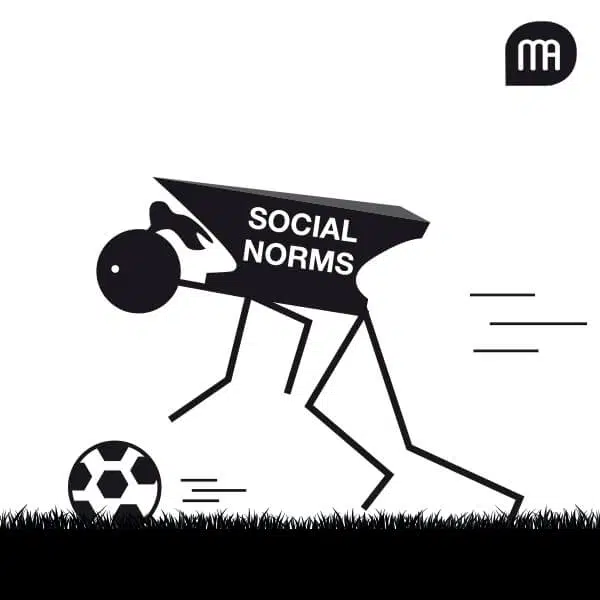
“Hedonic motives are the main reason why people follow women’s soccer and the USWNT [United States Women’s National Team]. Respondents indicated that they find women’s soccer to be a beautiful and entertaining sport and they like the feeling they get when they watch it or when their team wins.”
In conclusion, however, Coche points out the “socio-cultural barriers” stemming in particular from the social roles that women are supposed to assume:
“[…] Because of role expectations, women do not watch as much sports, including women’s sports, as men watch sports, or at least men’s sports. However, the affordability of and entry ease offered by the Internet could potentially enable women to overcome these socio-cultural barriers to fandom.”
The subject is not new. This was expressed, rather vividly, in an article published in 2002, this time in the context of women’s football in China. Their authors, Dong Jinxia and J.A. Mangan, stressed the need for women’s football to be organised in a modern way:
“Above all, gender attitudes must change. Here is the key to successful innovation. Retrogressive stereotyping must be replaced, anachronistic images of femininity must be set aside. Modern gender ideals must be promoted and put into practice.” (2)
These “retrograde stereotypes” are the subject of much research on women’s football. For example, the first sentences of the article by Paulo Roberto and his colleagues, published in Soccer & Society in 2014, referred to this state of affairs:
“The general sports world is historically considered a male institution. This is supported by both professional and media spheres which generally associate sports with concerns and interests belonging essentially to the male stereotype. Social gender construction within sports comes from different appreciation of attributes (strength and speed are generally related to male sports, while beauty and grace are mainly associated to the female ones).” (3)
In South America – and especially, in the following excerpt, from Argentina – women footballers have, since the end of the last century, displayed attributes that are in line with their traditional social role. David Wood mentions a study that highlights this fact – or, to put it another way, the fact that these women football players were not trying to imitate their male colleagues:
“[…] Findings of a more recent study of women’s football in Argentina suggest that by the turn of the millennium women at football grounds ‘no pierden sus atributos femeninos, antes bien, los exponen’ (do not lose their feminine attributes; rather, they display them) (Binello et al., 2000), resulting in acceptance at matches by men, whose heterosexuality and normative gendered behaviour thus goes unchallenged.” (4)
The fact of not losing visible attributes that make it possible to categorise a person, to assign her a predefined social role, can be the result of a calculation. The psychological situation of women football players (at least those who are in the media spotlight) can be represented as follows. Either they display attributes that correspond to the expectations of their female role, but then they may not appear sufficiently legitimate to the public, who consider that sport activity must be governed by male norms. Or they display male attributes or male ways of behaving, and then they take the risk of giving up something meaningful for themselves because, seeking external legitimacy, they imitate other role models. In her doctoral thesis in philosophy on the place of women in football in England, Joanna Welford analyses this typical choice (5). To support her views, she looks at other sports governed by male norms, such as women’s rugby and women’s ice hockey. She also includes issues related to the sexual orientation of players and gender identity, as well as the homophobic conduct of some spectators. In the following excerpt, Welford highlights the importance of the heterosexuality norm for players’ representations of how they should conduct themselves in the exercise of their sport:
“Research in this area has demonstrated how female footballers express frustration at the stereotypes they feel they have to overcome in order to continue their participation. Cox & Thompson (2000) describe how sportswomen experience conflict between athletic and feminine statuses, with being physical and athletic perceived as deviating from the norm. With heterosexuality as an organising principle, female footballers therefore must negotiate this conflict in a way that allows them to develop a muscular athletic body whilst maintaining a distance from both men and the lesbian stereotype.”
Imitating male norms is a conformist way of resolving conflict. It leads to maintaining the dominance of the male norm. This is also the case when a balance is found between female identity and conformity to male norms. With regard to rugby, Welford, referring to a study conducted in 1999, mentions the fact that “players had to display appropriate levels of conformity to feminine ideals, but were still expected to conform to dominant behaviour within the rugby culture, such as drinking after matches.” A third way to respond to this double-bind to which female footballers are subjected is to voluntarily, and ostensibly, adopt a deviant attitude towards male norms – which means “portraying non-conformant identities and taking pleasure from this.” In this sense, but also simply because so many women now participate in sports that were once played mainly by men, “the movement of women into football […] can therefore be understood to be an attempt to destabilise the male dominance of the sport, although with significant limitations.” And female footballers can, in turn, become role models, just as the American team’s female footballers won the 1999 World Cup in the United States. Actually, these players “became nationally known sports figures and heroes, role models for millions of young American girls who now aspire to be players” (6). In the next post, we will see how the behaviours we have described fall within the scope of Homo Sociologicus. Alain Anquetil (1) R. Coche, “What women’s soccer fans want: A Twitter study,” Soccer & Society, 15(4), 2014, p. 449-471. (2) D. Jinxia & J.A. Mangan, “Ascending then descending? Women’s soccer in modern China,” Soccer & Society, 3(2), 2002, p. 1-18. (3) P. R. C. Dalpian, V. Suslik Zylbersztejn, Z. Batistella & C. A. Vargas Rossi, “Fanatical women and soccer: An exploratory study,” Soccer & Society, 2014, 15(4), p. 564-577. (4) D. Wood, “The beautiful game? Hegemonic masculinity, women and football in Brazil and Argentina,” Bulletin of Latin American Research, 37(5), 2018, p. 567-581. The article quoted is the following: G. Binello, M. Conde, A. Martínez & M. G. Rodríguez, “Mujeres y fútbol. ¿territorio conquistado o a conquistar?” in P. Alabarces (ed.), Peligro de gol. Estudios sobre deporte y sociedad en América Latina, CLACSO, Buenos Aires, 2000. (5) J. Welford, What’s the score? Women in football in England, A doctoral thesis submitted in partial fulfilment of the requirements for the award of doctor of philosophy of Loughborough University, April 2008. Welford quotes B. Cox & S. Thompson, “Multiple bodies: Sportswomen, soccer and sexuality,” International Review for the Sociology of Sport, 35(1), 2000, p. 5-20. (6) A. S. Markovits & S. L. Hellerman, “Women’s soccer in the United States: Yet another American ‘Exceptionalism’,” Soccer & Society, 4(2-3), 2003, p. 14-29. [cite]




